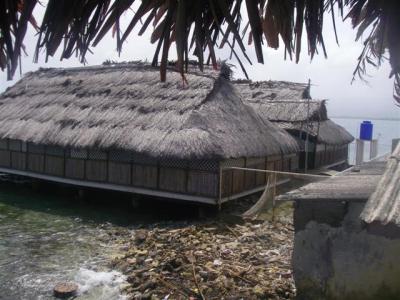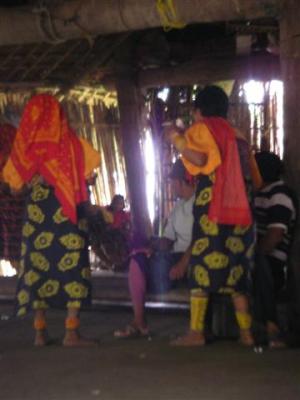When we were done at the museum, Jose locked up. Wow, John was right. He was closing for the cruise ship, which we found odd. John took us on a tour of the island. He showed us the two schools, both concrete bungalows. He took us a several nice view points. We got a good look at the fourth island that we hadn’t actually seen until just then.

He took us to the pier, which are two large concrete docks side by side. There was a big trawler loaded with propane tanks tied up to one of them. We guess propane must be how they cook. We passed a few tiny stores on the island, the biggest of them at the pier. We also passed a couple restaurants, one of them at the pier. And that was about it. The island is tiny and you can walk around the entire thing in about 10 minutes.
John escorted us to our dinghy and told us there would be dancing tonight at 1700 and invited us to come back for the dancing. We said we would.
We dinghied over to the next closest island and tied up to a nice concrete pier. The cruise ship doesn’t come to this island, so we expected people to be a little friendlier. When we got to the dock, two locals stared at our dinghy and one finally said “How many horse? 2?” When we said yes, he laughed.
This village looks almost identical to Carti Suitupo, except it is smaller and had less concrete buildings. We again said hi to everyone we passed as we walked down the main path on the island. No one said anything to us. We passed two teen boys who were playing alternative rock music and we told them we liked their music, to which they smiled. We passed a group of about a dozen women sitting outside a hut all chopping green bananas into tiny pieces. They all had huge bowls of banana in front of them, so it looked like they have been at it for a while.
When we got to the end of the walkway, we realized we had made a horseshoe and could see Kosmopolitan and the dock just a few hundred yards away as the crow flies. We were standing at the waterfront enjoying the view near a group of local guys. One of them offered us a beer, which took us by surprise. It was 0930. We then noticed that several of the guys in the group looked to be drunk. Apparently, last night’s party was still carrying on this morning.
Our new local friend chatted with us for a few minutes, but he was having a hard time comprehending our broken Spanish, and we were having a hard time with the unfamiliar Kuna accented Spanish. We gave up and walked back to the dinghy along the same path. This time the teen boys were playing Weezer’s “An Island in the Sun”, which we started to sing along to “on an island in the sun, we’ll be playing and having fun..” The music was curtly shut off and we realized we probably upset a mother who does not want her boys to be encouraged to listen to this stuff. We also wondered if they had any idea what the lyrics of the song are and how appropriate they are in the Comarca.
The men we had talked to at the pier earlier were gone. Now there were three teen boys, two sitting in the water, one passed out on the pier. As we were getting into the dinghy, the passed out boy got up and started talking to us. He was really, really drunk and his speech was seriously slurred. He had to repeat himself a couple times before we fully comprehended what he was saying, but he seemed happy to do so. He drank until 0400, then went surfing in the dark, then came back at 0500 and started drinking again. We told him he was crazy and he beamed with pride.
We headed over to the island directly behind it, the one that had been hidden from our line of sight when we came in. We repeated the routine, pulling up to a concrete pier and walking through town. Here there were a lot of women walking around carrying large bowls of rice. What is up with all the rice? And bananas? And big bags of food? This must all be in preparation for the big revolution day celebration tomorrow.
We again greeted everyone we passed, and this time we actually got some response. At the end of the pathway are a large two story bamboo hut, a small concrete building with a basketball court in front of it, and two little huts side by side built on a platform over the water. The two story hut was clearly having work done to it. Someone was out front sawing wood. Here are the huts on the platform.

A man invited us into the two story hut. We followed. He told us in Spanish that it is a hotel that is still not 100% completed. He gave us a quick tour of the downstairs, which consisted of a dining area, a small store selling a big selection of molas, a kitchen, and a community bathroom. He took us upstairs, which was lined with guest rooms. The rooms were pretty bare, most with hammocks, though a few had mattresses lying on the floor. There was a girl up there in her late teens. Physically speaking, she didn’t look very Kuna and she was wearing western clothing. Our new friend said she was the owner’s daughter, handed us off to her and vanished.
We were shocked when she said “Hi, I’m Stephanie”. There was no doubt she was American! How can this be? Only Kuna are allowed to own property and run businesses in the Comarca. We talked to her for a long time, finding out about her and the Kuna culture. It turns out that her grandparents on her mother’s side are Kuna Indians who had moved to Panama for work. Her mom grew up in Panama, then met her dad, who worked on one of the US air bases. Her parents married and he was eventually sent back to the States. She grew up mostly in the States.
Her mom recently inherited this piece of property in the Comarca and her parents decided to put a hotel on it. They wanted it to be rustic hotel with modern amenities. The other hotels in the area are rudimentary by modern standards. They said it has been a much more expensive and harder project than they had anticipated because modern amenities are difficult to get where they are. They are proud of the fact they have plumbing, real shower heads with water pressure, real flushing toilets, and electricity — all things most of the hotels in the area lack. They finally just got mattresses, which were hard to come by. The mattresses are not as nice as they were hoping to get, but higher quality ones simply weren’t available. They are still waiting for the mattress frames so the mattresses aren’t on the floor.
Stephanie told us that the Kunas don’t do much to celebrate weddings, babies, or birthdays, and the only real big life stage festivities are when a girl begins menstruating. It is a four day celebration. This island was currently having puberty party, and she said it sounded like the other two islands we had been to today are also having puberty parties. She said the dancing we had been invited to attend on the other island was “interesting and worth seeing”, but we probably wouldn’t want to stick around for too long. We suspect the reason every island is having one of these parties is because this is a long holiday weekend in Panama. The parents probably scheduled the parties for this weekend so relatives working in Colon and Panama City could attend, too.
We invited Stephanie over for dinner, telling her we’d pick her up when we were done at the dancing, then headed back to the boat. It was lunch time and we wanted to go back to Kosmos to get some lunch.
At the pier, we were greeted by a man who spoke English named Mr. G. He said he had lived in America for a short while and loved Americans. He offered to take us to tonight’s Puberty Party on this island. He said we couldn’t just walk in, we had to be escorted by a local and the local has to get permission from the chief for guests to be there. He told us to come back at 1400.
Back at Kosmos, Christi quickly threw together lunch and prepped dinner so it was ready to stick in the oven when we return. At 1400 we were back at the island. Mr. G was waiting for us at the dock. As we walked, he explained that the sacred chichi beer ritual was about to begin. Chichi beer is made from a mixture of sugar cane juice and coffee. The mixture sits for 8 days before you drink it. Mr. G had said the beer was non-alcoholic and that the “high” you feel when you drink it comes from the sugar and caffeine rush.
We followed him into a large hut that had benches scattered around. It looks like a meeting hall. A group of women in matching traditional attire sat in the front left corner. They had on red head scarves, an orange top, and a black skirt with a yellow design. Up close you could see that all the material was different, but it was similar enough that from the distance it looked like a uniform. We realize this is a terrible photo, but at least it gives you an idea of what their outfits look like. The Kuna don’t like their photos being taken the picture snapping tourists who gawk at them make them feel like zoo animals. If they catch you taking pictures, they want $1.00 per person per photo taken.

Men were scattered all around the rest of the room. Most of the men were casually dressed, but several had on derby hats, a feminine looking blouse hot pink blouse with gathers, and trousers.
The entrance is at the back, so not many people saw us enter since they had their backs to us. Mr. G found the chief and asked his permission for us to be there. Mr. G had expected the chief to have Christi sit in the front corner with the women, but he let the three of us sit together in the farthest back corner of the room.
The ceremony began. The men with the derby hats all congregated in a little area near the center of the room. Mr. G told us they are the village leaders. Everyone sat in silence as someone scooped chichi beer into half coconut shells, then brought the shells to the men in the derby hats. The men each drank their beer with an air that this was a grave undertaking, then walked over to the barrel and dipped the shell for another round, which was again drunk with an air of gravity. Once they had finished the second round, a man went around the room offering the coconut shells full of beer to each person. Most simply took the coconut shell and downed the beer, but several groups of men did a little dance prior to drinking theirs. The dance involved three or four people shoulder to shoulder in a circle. They would move to the left while hooting, then stop and bend their knees deeply, then move to the right while hooting. After a couple rounds of this, they ended the dance by gulping the beer.
To be continued”¦
